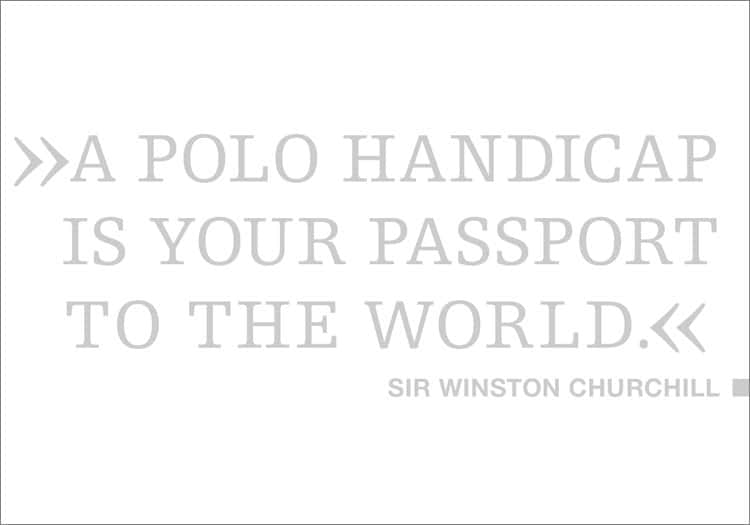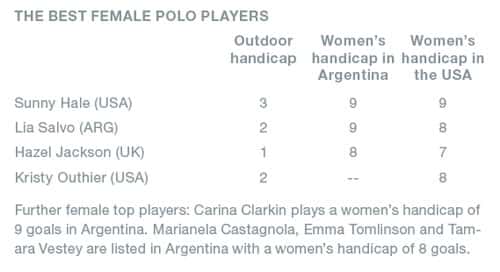The Polo Handicap

History of the polo handicap
British officers who were stationed in India towards the end of the 19th century brought polo to Europe. The Hurlingham Polo Club, founded here in 1876, was the first to set down the rules of polo in writing and these are still used in international sport today. The British also took the sport to North and South America. The polo handicap, however, did not originate with the English, but rather from Henry Lloyd Herbert, the first president of the United States Polo Association (USPA), who introduced a handicap system when he founded the USPA in 1890. From then on, the abilities of individual players could be compared and teams could be put together in a way that made them even despite individual differences in performance. In 1910, the English and Indians also introduced handicap systems. However, there is still no globally homogenous and all-encompassing system. The handicaps of players are determined by the respective country associations.
From beginner to professional: the scale
A handicap is not determined by goal and tournament success alone, but many other factors are also taken into account, such as sportsmanship, team play, knowledge of polo, strategy and horsemanship. The highest possible handicap is 10 goals. Not even a dozen people worldwide have this ranking, and it is primarily Argentinian polo families who dominate this top category. Of the nine 10-goalers currently playing, eight are from Argentina. The majority of the players does not achieve the upper end of the scale: two thirds of all players have a handicap of 2 goals or less. The exact division of the handicap scale is different according to each country.
Argentina: 0 to 10
USA: C (-2), B (-1), B+ (-0.5), A (0), A+ (0.5), 1.0, 1.5, 2 to 10
England: -2 to 10
The team handicap in a tournament is calculated from the individual handicaps of the players. For reasons of fairness, teams with lower team handicaps are given a so-called goal advantage.
The best of the best: the 10-goalers
There are currently only nine players across the world who have the highest possible handicap of 10 goals. As each country determines its own handicap, players in Argentina may play at 10 goals in Argentina, but they would be playing at just 9 goals in the USA. The differences are sometimes even greater than this.
 Go ladies: the women’s handicap
In polo, it is usual for men and women to play together in mixed teams. The number of female polo players is rapidly increasing and over the past few years, more and more ladies’ tournaments have been established. In order to increase the appeal of ladies’ tournaments, the Asociación Argentina de Polo (AAP) introduced special handicaps for women in 2012. The women’s handicap only applies to women-only tournaments – if women play together with men, the normal handicap applies. During the season, the women’s handicap commission observes players in the ladies’ tournaments and meets twice a year to discuss performance and possible handicap changes. At the end of 2011, the Fedération Française de Polo (FFP) adopted the Argentinian system. Since the start of 2014, a special women’s handicap has also existed in the USA. This year, the United Kingdom has caught up and introduced ladies’ handicaps in April 2015. In all other countries there is no special handicap system for women, and women-only tournaments are played with normal handicaps.
Go ladies: the women’s handicap
In polo, it is usual for men and women to play together in mixed teams. The number of female polo players is rapidly increasing and over the past few years, more and more ladies’ tournaments have been established. In order to increase the appeal of ladies’ tournaments, the Asociación Argentina de Polo (AAP) introduced special handicaps for women in 2012. The women’s handicap only applies to women-only tournaments – if women play together with men, the normal handicap applies. During the season, the women’s handicap commission observes players in the ladies’ tournaments and meets twice a year to discuss performance and possible handicap changes. At the end of 2011, the Fedération Française de Polo (FFP) adopted the Argentinian system. Since the start of 2014, a special women’s handicap has also existed in the USA. This year, the United Kingdom has caught up and introduced ladies’ handicaps in April 2015. In all other countries there is no special handicap system for women, and women-only tournaments are played with normal handicaps.
 Arena, Beach and Snow Polo
There are also separate handicaps for arena tournaments in the USA and United Kingdom. The best arena player in the USA is Thomas Biddle with an arena handicap of 10 goals. He plays at 6 goals on grass. In the United Kingdom, Chris Hyde was recently promoted and now also plays at 10 goals (outdoor 6 goals).
For beach and snow polo, there are no separate handicaps, but the normal handicaps are usually raised by one level.
Arena, Beach and Snow Polo
There are also separate handicaps for arena tournaments in the USA and United Kingdom. The best arena player in the USA is Thomas Biddle with an arena handicap of 10 goals. He plays at 6 goals on grass. In the United Kingdom, Chris Hyde was recently promoted and now also plays at 10 goals (outdoor 6 goals).
For beach and snow polo, there are no separate handicaps, but the normal handicaps are usually raised by one level.
 Go ladies: the women’s handicap
In polo, it is usual for men and women to play together in mixed teams. The number of female polo players is rapidly increasing and over the past few years, more and more ladies’ tournaments have been established. In order to increase the appeal of ladies’ tournaments, the Asociación Argentina de Polo (AAP) introduced special handicaps for women in 2012. The women’s handicap only applies to women-only tournaments – if women play together with men, the normal handicap applies. During the season, the women’s handicap commission observes players in the ladies’ tournaments and meets twice a year to discuss performance and possible handicap changes. At the end of 2011, the Fedération Française de Polo (FFP) adopted the Argentinian system. Since the start of 2014, a special women’s handicap has also existed in the USA. This year, the United Kingdom has caught up and introduced ladies’ handicaps in April 2015. In all other countries there is no special handicap system for women, and women-only tournaments are played with normal handicaps.
Go ladies: the women’s handicap
In polo, it is usual for men and women to play together in mixed teams. The number of female polo players is rapidly increasing and over the past few years, more and more ladies’ tournaments have been established. In order to increase the appeal of ladies’ tournaments, the Asociación Argentina de Polo (AAP) introduced special handicaps for women in 2012. The women’s handicap only applies to women-only tournaments – if women play together with men, the normal handicap applies. During the season, the women’s handicap commission observes players in the ladies’ tournaments and meets twice a year to discuss performance and possible handicap changes. At the end of 2011, the Fedération Française de Polo (FFP) adopted the Argentinian system. Since the start of 2014, a special women’s handicap has also existed in the USA. This year, the United Kingdom has caught up and introduced ladies’ handicaps in April 2015. In all other countries there is no special handicap system for women, and women-only tournaments are played with normal handicaps.
 Arena, Beach and Snow Polo
There are also separate handicaps for arena tournaments in the USA and United Kingdom. The best arena player in the USA is Thomas Biddle with an arena handicap of 10 goals. He plays at 6 goals on grass. In the United Kingdom, Chris Hyde was recently promoted and now also plays at 10 goals (outdoor 6 goals).
For beach and snow polo, there are no separate handicaps, but the normal handicaps are usually raised by one level.
Arena, Beach and Snow Polo
There are also separate handicaps for arena tournaments in the USA and United Kingdom. The best arena player in the USA is Thomas Biddle with an arena handicap of 10 goals. He plays at 6 goals on grass. In the United Kingdom, Chris Hyde was recently promoted and now also plays at 10 goals (outdoor 6 goals).
For beach and snow polo, there are no separate handicaps, but the normal handicaps are usually raised by one level.


